 Planting Shrubs
Planting Shrubs
 Planting
Planting
 Watering
Watering
 Spacing
Spacing
 Mulching
Mulching
 Fertilizing
Fertilizing
Planting shrubs 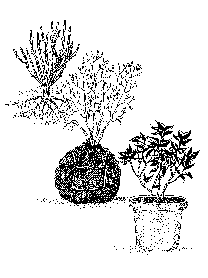 is one of the smartest
things you can do - both for yourself and your community. Shrubs can help
increase the value of your property and provide privacy and beauty around your
home.
is one of the smartest
things you can do - both for yourself and your community. Shrubs can help
increase the value of your property and provide privacy and beauty around your
home.
Your shrub will come in one of four forms: barerooted, balled and burlapped
(B&B), container-grown, or containerized. Plant bare-rooted shrubs in the late
fall or early spring. Only deciduous plants are sold bare-rooted. Do not buy or
plant a bare-rooted shrub which shows new growth. Container-grown plants or
balled-and- burlapped shrubs may be planted at any time except when the ground
is frozen. Some plants are containerized at the retail outlet; the retailer
receives the plants either bare-rooted or balled-and-burlapped, and then pots
them with soil. Make sure these plants have well-developed roots that hold the
soil together when removed from the pot.
If possible, plant your shrub as soon as you get it home. Otherwise, it may
dry out and be injured. If you can't plant immediately, place it in a shady or
sheltered spot. Cover the roots of bare-rooted shrubs with moist soil, sand, or
peat moss. Keep the soil of balled-and- burlapped or container plants moist
until planting.
Return to Table of Contents
Since wet soils can reduce plant growth and survival, you should plant in a
well-drained soil. To test for soil drainage, dig the hole for your new plant
and fill it with water. If the water doesn't drain in 24 hours, plant elsewhere.
To plant the shrub, dig a hole at least twice as wide as the diameter of the
shrub's root spread or root ball. Do not dig too deep; once the plant is placed
in the hole, the top of the roots or root ball should be level or slightly above
level with the surface of the ground. Remove all tags, wires, or ropes from the
stems or trunk. These can strangle and kill the plant as it grows.
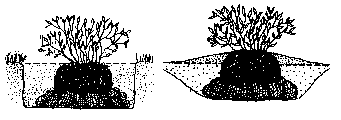 If the shrub is in a container, ease it
out carefully without disturbing the root ball. Save the plastic pot to recycle.
Cut any circling roots, then place the root ball in the hole. For balled-and-burlapped
plants, place the plant in the hole before removing the burlap covering. Then,
to ensure root growth and access to nutrients and water, pull the burlap down
off the root ball and leave it in the bottom of the hole. Do not attempt to pull
the burlap from under the plant - this could damage the root ball. If a
balled-and-burlapped root ball is enclosed in a wire basket, and there is no
other covering, the basket can be left in place. Cut the wires so they are all
below the soil surface so they do not interfere with raking or cultivation.
If the shrub is in a container, ease it
out carefully without disturbing the root ball. Save the plastic pot to recycle.
Cut any circling roots, then place the root ball in the hole. For balled-and-burlapped
plants, place the plant in the hole before removing the burlap covering. Then,
to ensure root growth and access to nutrients and water, pull the burlap down
off the root ball and leave it in the bottom of the hole. Do not attempt to pull
the burlap from under the plant - this could damage the root ball. If a
balled-and-burlapped root ball is enclosed in a wire basket, and there is no
other covering, the basket can be left in place. Cut the wires so they are all
below the soil surface so they do not interfere with raking or cultivation.
Before planting bare-rooted shrubs, remove damaged or diseased roots with
clean, sharp pruning shears. Untangle and spread the roots to a natural
position. Then place the plant in the hole. For very heavy clay or compacted
soils, the root ball may be one third above the soil surface.
When replacing the soil in the hole, do not add organic matter. If the
original soil, or backfill, contains too much rock or construction debris,
replace it with local topsoil. When the hole is about three fourths refilled,
level and turn plant if necessary; tamp the soil down gently. Water the shrub
heavily to eliminate air pockets. Then finish filling the hole with backfill to
its original level. Use excess soil to build a berm or ring about 6 inches from
the outside edge of the hole. Then water heavily again.
If shrubs are to be mass planted in a bed or where the entire planting area
can be worked, the soil can be amended by incorporating 3 to 5 inches of organic
matter into the entire bed to the depth equal to the height of the root ball.
The shrubs are then planted into the amended area.
Return to Table of Contents
Watering during dry periods of the first growing season is crucial,
especially with container-grown plants. Container and balled-and-burlapped shrub
roots dry out faster than the soil around them, so -it is particularly important
to monitor 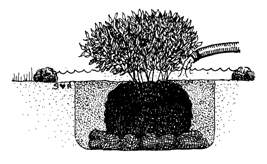 their soil moisture. In the
nursery, the roots of container and balled-and-burlapped shrubs become
concentrated in a small root ball which is watered daily. After planting, the
roots of these shrubs will eventually spread into surrounding soil. Until that
happens, however, the shrubs continue to draw water mostly from their root ball.
Consequently, if the soil near the trunk is dry, shrubs need water.
their soil moisture. In the
nursery, the roots of container and balled-and-burlapped shrubs become
concentrated in a small root ball which is watered daily. After planting, the
roots of these shrubs will eventually spread into surrounding soil. Until that
happens, however, the shrubs continue to draw water mostly from their root ball.
Consequently, if the soil near the trunk is dry, shrubs need water.
Water heavily once a week during periods of no rain. Use a garden hose to
slowly soak the soil. Always allow the water to reach the top of the berm built
around the plant. This will provide deep water penetration and encourage
widespread root development. Always check the soil moisture before watering to
avoid overwatering as this can kill the plant.
Return to Table of Contents
Anticipate the mature size of shrubs. Shrubs should never be planted too
close to building foundations or walkw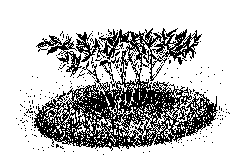 ays.
Otherwise, when fully grown they may block windows, crowd or damage buildings,
and interfere with foot traffic.
ays.
Otherwise, when fully grown they may block windows, crowd or damage buildings,
and interfere with foot traffic.
Return to Table of Contents
Place mulch (pine needles, straw, bark chips, or slightly decomposed or
shredded leaves) 2 or 3 inches deep around the shrub. Mulch will reduce
evaporation of water and reduce weed and grass growth around the plant. It also
protects the shrub from lawn mower and string trimmer injury. Avoid overly deep
mulch or piling the mulch up against the trunk of the shrub; this promotes
shallow roots, disease, and pest injury.
Return to Table of Contents

Applying the correct fertilizer at planting helps ensure healthy plants.
Incorporate a slow-release fertilizer, preferably composed of 25 to 50 percent
water insoluble nitrogen (WIN), into the soil backfill at planting time.
If your plant's growth is slow or its leaves appear paler than normal, have
the soil tested (ask your local Extension agent for soil test forms and
instructions) and follow the resulting recommendation. After the plant is
established, check with your local Extension office to establish a regular
program of fertilization.
![]() Gardeners' Corner
Kids'
Garden
Sustainable Garden
Contact Us
Gardeners' Corner
Kids'
Garden
Sustainable Garden
Contact Us![]()
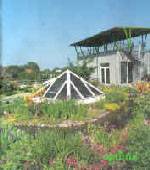


 is one of the smartest
things you can do - both for yourself and your community. Shrubs can help
increase the value of your property and provide privacy and beauty around your
home.
is one of the smartest
things you can do - both for yourself and your community. Shrubs can help
increase the value of your property and provide privacy and beauty around your
home.  If the shrub is in a container, ease it
out carefully without disturbing the root ball. Save the plastic pot to recycle.
Cut any circling roots, then place the root ball in the hole. For balled-and-burlapped
plants, place the plant in the hole before removing the burlap covering. Then,
to ensure root growth and access to nutrients and water, pull the burlap down
off the root ball and leave it in the bottom of the hole. Do not attempt to pull
the burlap from under the plant - this could damage the root ball. If a
balled-and-burlapped root ball is enclosed in a wire basket, and there is no
other covering, the basket can be left in place. Cut the wires so they are all
below the soil surface so they do not interfere with raking or cultivation.
If the shrub is in a container, ease it
out carefully without disturbing the root ball. Save the plastic pot to recycle.
Cut any circling roots, then place the root ball in the hole. For balled-and-burlapped
plants, place the plant in the hole before removing the burlap covering. Then,
to ensure root growth and access to nutrients and water, pull the burlap down
off the root ball and leave it in the bottom of the hole. Do not attempt to pull
the burlap from under the plant - this could damage the root ball. If a
balled-and-burlapped root ball is enclosed in a wire basket, and there is no
other covering, the basket can be left in place. Cut the wires so they are all
below the soil surface so they do not interfere with raking or cultivation.  their soil moisture. In the
nursery, the roots of container and balled-and-burlapped shrubs become
concentrated in a small root ball which is watered daily. After planting, the
roots of these shrubs will eventually spread into surrounding soil. Until that
happens, however, the shrubs continue to draw water mostly from their root ball.
Consequently, if the soil near the trunk is dry, shrubs need water.
their soil moisture. In the
nursery, the roots of container and balled-and-burlapped shrubs become
concentrated in a small root ball which is watered daily. After planting, the
roots of these shrubs will eventually spread into surrounding soil. Until that
happens, however, the shrubs continue to draw water mostly from their root ball.
Consequently, if the soil near the trunk is dry, shrubs need water.  ays.
Otherwise, when fully grown they may block windows, crowd or damage buildings,
and interfere with foot traffic.
ays.
Otherwise, when fully grown they may block windows, crowd or damage buildings,
and interfere with foot traffic. 